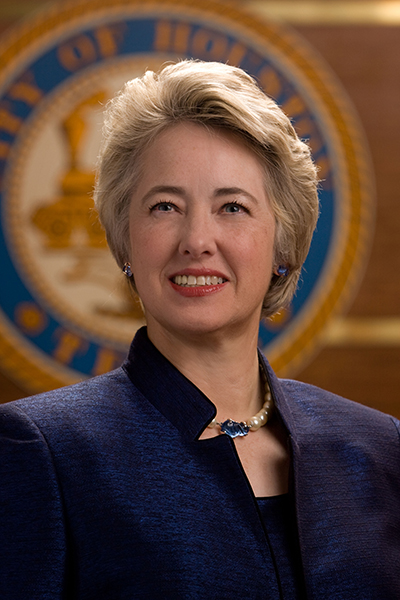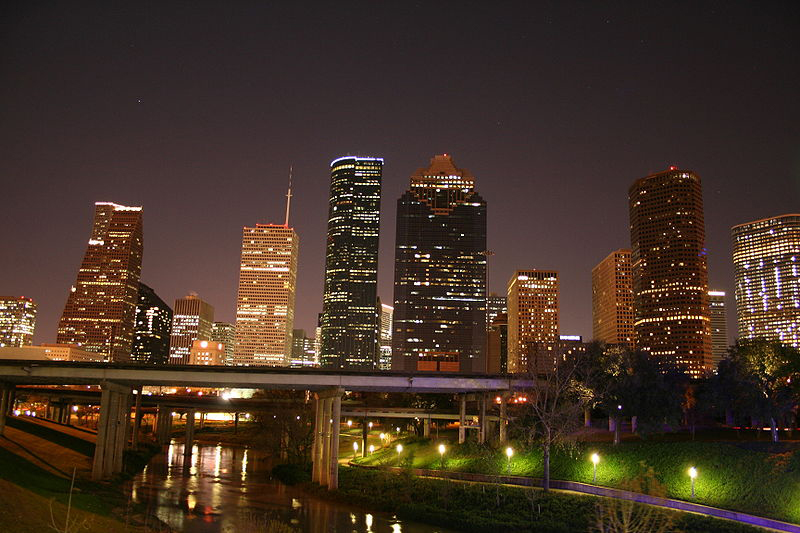Flood, drought, heat, and cities
Interview | Annise Parker, mayor of Houston
May 14, 2012 - by Staff
May 14, 2012 - by Staff
May 14, 2012 • The atmosphere has dealt Houston more than a few wild cards over the last few years. The twin strikes of Tropical Storm Allison (2001) and Hurricane Ike (2008) caused billions in damage and took dozens of lives in the greater Houston area. Now in her second term as mayor of the nation’s fourth largest city, Annise Parker guided Houston through the severe drought of 2011, which killed many trees both locally and across Texas. Along with tackling various weather threats, the city has also taken steps to tackle the longer-term threat of climate change. Last year Houston won first place among large cities in the Climate Protection Awards sponsored by the U.S. Conference of Mayors (award citation - PDF).
What’s your overall philosophy on what climate change means to Houston and Houstonians, in particular?

(Courtesy Houston Mayor's Office.)
The uncertainty of the climate can cause many challenges for our city. From intense storm surges to prolonged heat waves to extreme drought, we realize the importance of having a more resilient city in the face of any serious weather event. This means planning ahead and understanding the potential risks that we may encounter and making sure our city is able to respond to our citizens’ needs. We understand the need to continue reducing our greenhouse emissions, but we also realize that we need to be able to adapt to future climate risks.
How do you and your staff prioritize the most fruitful areas where the city can take action on sustainability and climate adaptation?
We have staff who are very experienced with emergency preparedness and who understand how adaptation and sustainability can fit together. We recently purchased 17 solar-powered mobile response units that include generators and other facilities. They were designed locally at the University of Houston and made from shipping containers. These units will be used for emergency relief efforts for future hurricanes and will serve as recovery units to charge equipment as needed. They can also be used as relief centers during extreme heat events or for educational outreach demonstrations. This is just one of the many examples where we capitalize on local resources and utilize their products to take action on adaptation and promote sustainability efforts. When the city government and community work together, that’s where we see great success.
You launched a Green Office Challenge recently to help encourage energy efficiency. Where do you see that program heading?

Bayous crisscross the low-lying Houston area, sometimes carrying huge amounts of runoff after heavy rain. (Wikimedia photo by Bobby L. Warren.)
The Houston Green Office Challenge has seen great success in its first year, from the creation of new office green teams to increased building efficiencies to large e-waste recycling events. With nearly 400 participants in the first year, we hope to keep everyone engaged for another year and bring in even more participants, including NASA and the Johnson Space Center. We want to engage more city departments and focus on encouraging a positive behavior change.
We’re also looking forward to increasing our Energy Star and LEED [Leadership in Energy and Environmental Design] certifications. My goal is for Houston to be number one in the country for both of these.
Our metropolitan area has placed among the top 10 U.S. cities with the most Energy Star–certified buildings for each of the three years that the ranking has been available. In 2010, Houston was ranked number seven, with 175 large buildings certified.
The Houston region is tied for fourth place in the nation for LEED Certified projects. As of May 2012, our region had 176 LEED Certified buildings, eight of which achieved Platinum certification. In overall registered and certified LEED projects, including those not yet completed, Houston ranks fourth with 518 LEED projects. We definitely are making our way to number one!
How do you manage the potential tensions in addressing climate change in a city where the oil and gas industry is such a major presence?
Some of the greatest support for our sustainability efforts has come from the oil and gas industry. With peak oil demand becoming a more significant issue, many of the companies in Houston understand the need to look to a new energy frontier in renewable and alternative power sources. There are many robust company-led environmental initiatives, ranging from biodiversity investments to urban reforestation. While many groups will continue to debate the industry’s impact on the environment, these major players are not only important to the economic vitality of our city but also key to making advancements in finding clean energy solutions and diversifying our energy portfolio.
Even though Texas is prolific in oil and gas, we are also the largest producer of wind energy in the country. Houston has capitalized on this: we are the nation’s largest municipal purchaser of renewable power, with 33% of our power needs coming from wind generation in west Texas.
What lessons did Houston learn during the severe drought of 2011 that may help address future swings in water availability?

Thousands of pine trees were lost in Houston's Memorial Park, out of millions lost statewide after the drought of 2011. (Image courtesy KUHF-FM.)
Houstonians saw drastic change in our landscape. We lost thousands of trees in urban areas, such as Memorial Park, and we had to implement mandatory water conservation measures throughout the city. Our water is a precious resource, and this problem was not just a citywide issue but a statewide issue. We all have a responsibility to manage our water usage. We encourage utilizing simple technologies like installing rain barrels or using native, drought-tolerant plants in landscaping. Our building code allows for the reuse of rainwater for both potable and non-potable uses, so we hope everyone starts thinking creatively about how to save water.
Houston is famously an air-conditioned city. Did you take any special steps to avoid heat-related deaths during the record-hot summer last year?
During extreme heat events, the City of Houston activates our Heat Emergency Plan and opens cooling centers to citizens without access to air conditioning during heat waves. These locations include city libraries, multiservice centers, and park and recreation centers. We also encourage citizens to avoid being outdoors during the hottest part of the day, or at least to find shade if they have to be outdoors.
Heavy rains are a perennial Houston problem, and the heaviest rainfall events may get even heavier in a warming climate. What is Houston doing to keep its flood-related infrastructure up to date?
After Houstonians passed the Rebuild Houston initiative in 2011, the city is now able to utilize a new revenue source to update aging infrastructure. This proposition directed the city charter to be amended to provide for the enhancement, improvement, and ongoing renewal of Houston’s drainage and streets by creating a dedicated pay‐as‐you‐go fund for drainage and streets. Rebuild Houston will help reduce street flooding, improve mobility and reduce structural flooding.
How do you muster interest in a long-term problem like climate change and adaptation in the midst of immediate concerns and tight budgets?
I think the key is to emphasize the fact that if Houston wants to continue to be a vibrant and dynamic city, we need to be resilient in the face of any kind of natural disaster or a changing climate. Even though some of the problems are long term, we’re already seeing changes in the short term. Our sustainability efforts are an investment in the city and our future. It’s a way of insuring our assets and our people.